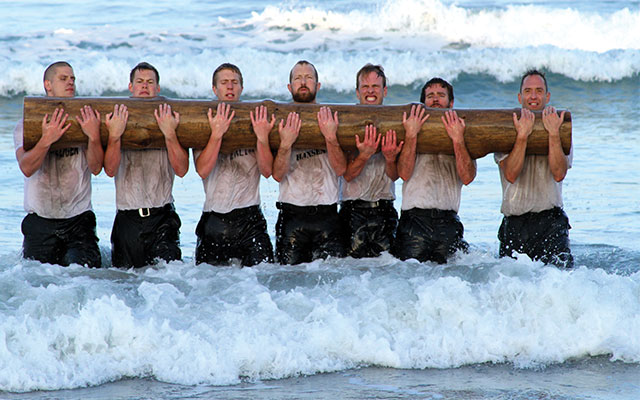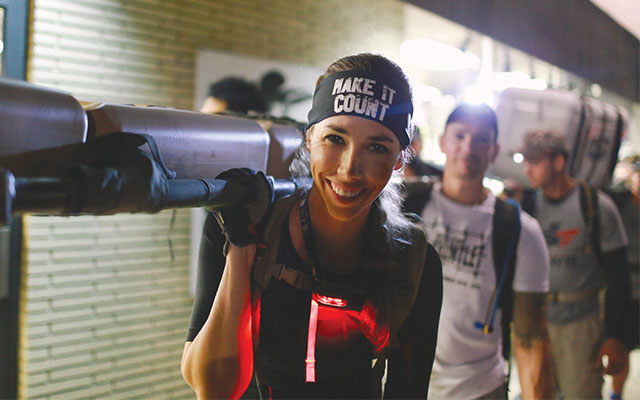New York’s Coney Island: sunshine, hot dogs, amusement rides, and laughter, right?
Nope — not at 6 p.m. on a miserably cold and windy April night, as my teammates and I wade into the icy-cold Atlantic Ocean. By 1 a.m., the ghostly bulbs of the Parachute Jump and the Cyclone are casting long shadows on us as we jog barefoot on the iconic boardwalk, each of us holding our boots in our hands. Any rays of sunlight have long disappeared, along with all of our food. Smiles and chuckles belong to only the sinister cadre leaders yelling at us to complete this 12-mile run in the allotted time.
I’ve only just begun this GORUCK Heavy, the gnarliest race I’ve ever entered. (Yes, I willingly forked over $200 for this experience.) But, as I discovered during the next 18 hours, it’s also one of the most rewarding. Not because of my time, but because of my team: 70 men and women — OK, mostly men, with a handful of “Ruckettes” — united as one.
Instead of barbed wire or rope ladders, we’re facing real, military-inspired obstacles: how to help each other get from point A to point B without buckling under the pressure of our packs, our sharp-tongued leaders, or our own fears.
Welcome to the world of extreme team adventures, where fitness takes on a different dimension. Designed to push participants beyond their boundaries while bonding with others, these events mix monumental physical challenges with equally taxing mental pressures. The result, very often, is a transformational experience.
Such adventures tend to last longer than typical obstacle-course races, and feature far tougher tasks: carrying 35-pound rucksacks for 40-plus miles, for example, or sitting in an ice-cold pond at the crack of dawn. And because many of these events are run by military veterans who love to bark orders and replicate the rigors they’ve experienced in their own training, there’s an extra dose of devilish demands.
But, as I realized that day in New York, you’re never alone. The weights become “team weights” and the shock of freezing water is shared by the people working alongside you.
“With teammates, you’re more invested in the outcome, and you can focus on something different from how miserable you might be at that moment in the event,” explains Octavio Paguaga, 33, a Washington, D.C., teacher who’s completed numerous GORUCKs.
“You don’t have to be a superstar,” he says. Doubt is part of the game. “You look inward: ‘Can I make it?’ And if you’re feeling good, you can ask yourself, ‘How can I help other people on my team?’”
Camaraderie Is Cool
The past decade has seen the loneliness of the long-distance runner give way to the camaraderie of an extreme-adventure crowd. Partner races like California’s Endeavor Team Challenge and group events like GORUCKs are taking the country by storm. Tasks include trekking over uneven terrain, carrying sandbags, and doing sit-ups. It’s a hard-boiled, sometimes-harrowing hobby. But it’s also a popular one: Participation in adventure racing nearly doubled from 2009 to 2012, according to The Outdoor Foundation, the nonprofit arm of the Outdoor Industry Association.
GORUCK events began in 2010 as a marketing tool for the gear company of the same name and have since grown exponentially.
Thanks to private Facebook groups and “ruck-off” gatherings promoted via email, more than 30,000 people have earned the patches that serve as postrace prizes. But don’t expect to post social updates from the course. Smartphones are prohibited during the races.
“We’re teaching people how to think outside themselves,” says Kit Klein, a partnership manager and photographer for GORUCK, which puts many of its staff members through the grueling events to gain a better perspective. “It’s about getting uncomfortable — and in the process, becoming more comfortable with other people.”
Only about half of those who start a GORUCK Heavy stagger across the (invisible) finish line more than 24 hours later. The 48-hour-plus GORUCK Selection is even tougher, with less than 5 percent of the field finishing. But 94 percent of entrants typically complete the Tough (about 10 to 12 hours), and the four- to five-hour Light experience boasts a 100 percent finish rate.
That success rate is a result of the personal connections these adventures create. There’s a bigger push to finish when you feel bonded with others.
“Humans are inherently social creatures,” says Kimo Seymour, senior vice president of media and events for Life Time — The Healthy Way of Life Company. “These new events appeal to our social need to be part of a group.”
You’d Better Be Ready
Like GORUCK, SEALFIT Kokoro Camp bridges the military and civilian worlds by putting rookies through the same rigors that special-ops candidates endure: If round-the-clock push-ups and regular encounters with ice-cold water don’t offer enough of a challenge, “buddy carries” probably will, since they involve marching seemingly endless distances with a full-grown man or woman on your back.
How can you possibly prepare for such a daunting ordeal? There are prerequisites in place for many extreme team adventures. Kokoro Camp, for example, requires a preevent test: Hopeful participants must complete 50 sit-ups in two minutes and 50 air squats in two minutes, among other physical challenges. The Endeavor Team Challenge, meanwhile, offers a blueprint for training on its website, covering everything from knots and orienteering to fueling and foot care.
“If you haven’t been working out, you’re going to struggle,” says GORUCK’s Klein, who adds that he typically sees a few intrepid couch potatoes at each event anyway.
Once you’ve forked over the entry fees, which can be as steep as $1,695 for a SEALFIT Kokoro Camp experience, it pays to train in advance, ideally in a team of two.
“Get to know each other, and not over a cup of coffee,” says Mark Silvers, Endeavor’s director of marketing and business development. “Do something difficult, something that pushes at least one member of the team outside of his or her comfort zone. Figuring out how to help each other is a critical piece of building a team, and not everyone functions the same way or has the same reaction to stress.”
And, yes, there will be stress. Sometimes, it’s produced by an outside force, such as a cadre leader barking orders for a bear crawl through Manhattan’s Central Park (which I experienced), or an actual bear that appears in the mountains (which, fortunately, I did not). But in team events that involve the mental attitudes of more than one individual, it’s wise to expect the unexpected. The most common reason people drop out, Klein notes, is a lack of mental preparation.
“We’re not moving very fast; it’s one step after another,” says Klein. “But if you’re thinking ahead too far, not living in the moment, you get a little bit of quit in your head.”

All Together Now
During my GORUCK experience, I had a lot of quit in my head — constantly fantasizing about dropping my pack and hailing a cab. But then, thanks to a turn toward kindness from cadre John, we stopped at Applebee’s for a pee break and bacon (I kid you not). Later, in Central Park, we posed with Big Bird and figured out how to carry what must have been the largest log in the Empire State. Each instance involved teamwork, and as soon as I stopped thinking, everything clicked into place.
Paguaga told me he once marched down the National Mall singing “99 Bottles of Beer on the Wall” after a divide-and-conquer moment of teammates sharing each other’s packs.
These adventures have helped him become a better teacher, he admits. “I tell my students, ‘Break a big problem into a small problem. Don’t worry about 15 steps from now; worry about what happens next. Go with the flow.’”
The risks are real: After investing hundreds of dollars in the entry fee, preparation, and gear — high-tech backpacks, along with sturdy shoes and waterproof clothing, are de rigueur — it’s entirely possible to twist your ankle in hour two, or to get lost among the hills of a ski resort, as I did during an Endeavor Team Challenge.
But with their reputations at stake, organizers have strict safety measures in place, and you can count on your teammates having your back, too.
Once, my Endeavor partner, Tyler (who was also on my GORUCK team), helped me carry bricks, and later long-jumped firewood across a balance beam so that I could complete the task of cooking Jiffy Pop. The memory of those first few kernels, and also the friendship that sparked during our relentless efforts to solve problems as a single unit, still makes me weepy.
“Nothing will be easy, but you can work smarter as a team,” says Michael Knaisch, 38, of Lakeland, Fla., who adds that he “cried like a baby” after finishing a GORUCK Selection. “Next to my wife giving birth, it was the most emotional moment of my life. It was a life changer.”
Are You Ready for This?
If you’re on the fence about signing up for an extreme adventure, ask yourself the following questions. More “yeas” than “nays” indicates you may be up for an extreme team event.
1. Are you willing to devote a few hours each week to train, by yourself and with a friend?
2. Are you prepared to be uncomfortable for several hours at a time?
3. Are you excited about meeting new people and building new friendships?
4. Are you willing to work with others to solve a challenge?
5. Are you able to focus on short-term tasks instead of worrying about the long term?
6. Do you like being outdoors for long stretches of time?
7. Are you comfortable leaving your smartphone behind?|
SEALFIT Kokoro Camp Test
SEALFIT Kokoro Camp is one of the most intense nontraditional athletic events on the market today. “The workload at Kokoro Camp was described by an IRONMAN athlete as ‘three back-to-back IRONMAN races, without rest,’ according to the Kokoro Camp website. “It is intensely physical, probably beyond anything you can imagine now. Prepare well.”
Think you can handle it? First check out these prerequisites, which all participants must fulfill within the first few hours of the camp:
- 50 pushups (40 for women) in two minutes, 50 sit-ups in two minutes, and 50 air squats in two minutes, with two minutes of rest between each.
- 10 dead-hang pull-ups for men, six for women.
- One-mile run in boots and utility pants on the road in under 9:30.
- Body Armor (a.k.a. “Murph”) with 20-pound pack (15-pound for women): 1-mile run, 100 pull-ups, 200 pushups, 300 squats, and another 1-mile run completed in less than 1 hour and 10 minutes.
Additionally, the following endurance standards are tested for completion (not performance):
- 10-mile run in less than 1 hour and 20 minutes
- 20-mile ruck hike with load in less than six hours
Train for your nontraditional team event with a workout plan at: The Ultimate Obstacle Course Workout




This Post Has 0 Comments